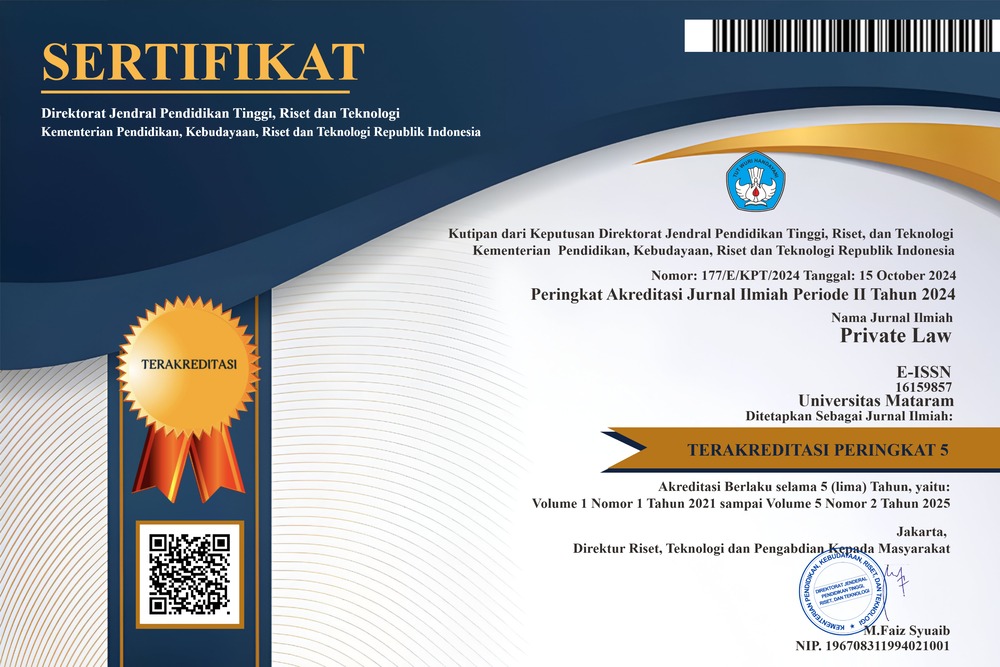Author Guidelines
Private Law is an open-access and peer-reviewed journal. We are interested in topics related to Law and Justice over the world. Articles submitted might cover topical contemporary legal issues including but not limited to the contract law, tort law, property law, family law, inheritance law, commercial law, corporate law, consumer protection law, intellectual property law and private international law
Authors are invited to submit manuscripts that fall within the scope of the Private Law, University of Mataram. Please read the information on the peer-review process.The articles published in Private Law should be written in English or Indonesian, which are going through a double-blind peer-review process. Hence, the decision on whether the scientific article is accepted or not, will be the Editorial Board’s right based on the peer reviewer's recommendation.
Important Note: If English is not your first language, we appreciate if the manuscript has passed the proofreading process by a native or a trusted proofreading institution.
Paper Format
Title Of Articles
Full Name First Author
Faculty of Law, Universitas Mataram,
Author’s email : Author1@unram.ac.id
Full Name Second Author
Faculty of Law, Universitas Mataram,
Author’s email : Author2@unram.ac.id
Etc.
ABSTRACT
Abstracts are written in English with times new roman (10pt) and prefeably not more than 250 words. The abstract should be clear, concise, adn descriptive. This abstract should provided a brife information to the problem, objective of paper, followed by a statement regarding the methodology and a brief summary of results. The abstracts not using references.
Keywords
Consist of three keywords that reflect the essential point of the article, arranged alphabetically, and separated by semicolon (;)
Example: Judiciary; Justice; Restoration.
I. INTRODUCTION
The introduction should be clear and provide the issue to be discussed in the manuscript. Before the objective, authors should provide an adequate background, and very short literature survey in order to record the existing solutions, to show which is the best of previous researches, to show the main limitation of the previous researches, to show what do you hope to achieve (to solve the limitation), and to show the scientific merit or novelties of the paper. At the end of the paragraph, the author/s should end with a comment on the significance concerning identification of the issue and objective of the research.
At the end of the paragraph, the author/s should end with a comment on the significance concerning identification of the issue and objective of the research.
Each paragraph should contain at least 2 sentences and span 4 lines. The introduction section should not exceed 3 pages.
II. METHOD
This method is written in descriptive and should provide a statement regarding the methodology of the research. This method as much as possible to give an idea to the reader through the methods used. This Method are optional, only for original research articles. The method should be written in paragraph form, without bullet points, and must not exceed 8 lines
III. ANALYSIS AND DISCUSSION
This section is the most important section of your article. The analysis and discussion should be clear and concise. The results should summarize (scientific) findings rather than providing data in great detail. Please highlight differences between your results or findings and the previous publications by other researchers.
Following main headings should be provided in the manuscript while preparing. The separation between main headings, sub-headings and sub-sub headings should be numbered in the manuscript with following example:
- Main Heading of the First Analysis or Discussion (if more than 2 discussions)
- Sub-heading of the discussion
- Sub-heading of the discussion
- etc ....
- Main Heading of the Second Analysis or Discussion
- Sub-heading of the discussion
- Sub-heading of the discussion
- ....
- ...
IV. CONCLUSION
The content of this section is:
- Conclusion
Conclusion contains a description that should answer the objectives of research. Provide a clear and concise conclusion. Do not repeat the Abstract or simply describe the results of the research. Give a clear explanation regarding the possible application.
- Recommendation
Recommendations are advisory statements written in a single paragraph, intended to serve as a basis for the development of legal theory or practice in the future.
*References
Private Law Journal uses the Chicago Style in Citation Style. Cite only items that you have read and written on footnotes. Please use Reference Manager Applications like Mendeley, Zotero. Use other published articles in the same journal as models. All publications cited in the text should be included in the References section and arranged alphabetically. For example: Book[1], Book Chapter[2], Journal[3], Website[4]. The references using books or published articles within the last 5 years to ensure the relevance and accuracy of the data.
BIBLIOGRAPHY
Bibliography at the end of the manuscript should be written in Chicago Style of Citation Style, with Times New Roman (12pt) and space of list Bibliography (1.5). All publications cited in the text should be included as a list of Bibliography, arranged alphabetically by author.
Book with an author:
Marzuki, Peter. Metodelogi Hukum. Tanggerang: Rajawali Press, 2010
Jounal article:
Jaya,mardi arya, dkk., Analisis Faktor Keberhasilan Start Up Digital di Yogyakarta. Prosiding SNATIF ke-4 (2017). (ISBN: 98788-602-1180-50-1)
Kendah, Ndohbea. Implementasi PPID pada Pemerintah Provinsi Gorontalo. Jurnal Penelitian Komunikasi dan Opini Publik. Vol. 19. No. 3 (Desember 2015).
World Wide Web:
Kabar Berita Radio, “Kompensasi Bagi Korban Terorisme”, https://kbr.id/09-2017/Kompensasi_bagi_korban_terorisme/92617.html, diakses, September 6, 2019,
*The article should have at least 15 pages and preferably not more than 20 pages, for direct cited should be indented by 7 spaces.
**The citation composition must consist of at least 70% journal article, with a minimum of 15 reference in total (5 Books dan 10 Jounal article)
Example for footnote:
[1]Sri Hajati, dkk., Politik Hukum Pertanahan Indonesia (Surabaya: Airlangga University Press, 2021), 2.
[2] Eddy O.S Hiariej, “Pemilukada Kini dan Masa Databf Perspektif Hukum Pidana,”, ed. Achmad D. Haryadi (Jakarta: Konstitusi Press, 2012) 87.
[3]Ana Silviana, “Pemanfaatan Tanah Di Atas Hak Pengelolaan Antara Regulasi Dan Implementas,” Diponegoro Private Law Review 1, no. 1 (2017): 36–45, www.jstor.org/stable/43832354.
[4] Kabar Berita Radio, “Kompensasi Bagi Korban Terorisme”, diakses, September 6, 2019, https://kbr.id/09-2017/Kompensasi_bagi_korban_terorisme/92617.html.











